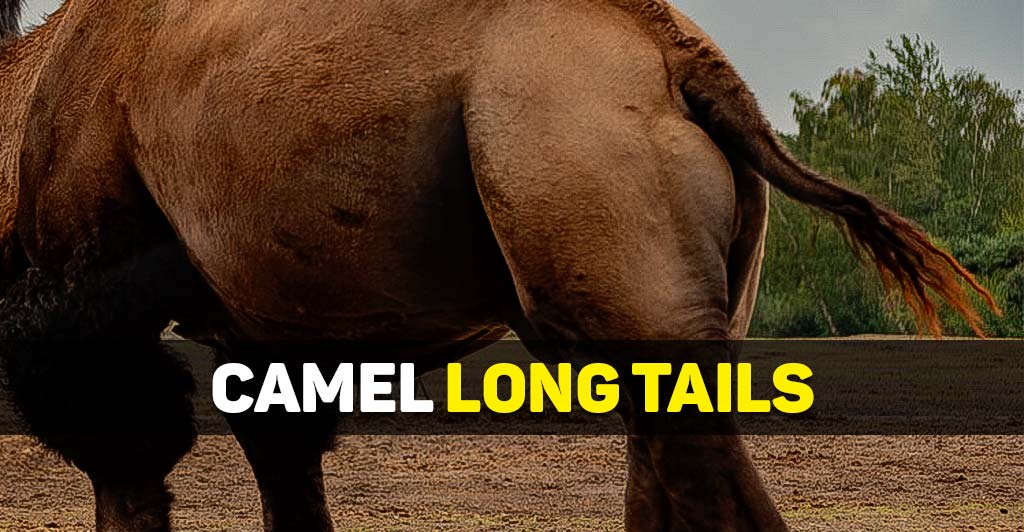When you think of a camel, the first thing that crosses your mind has to be its characteristical hump(s).
Or maybe you think a bit differently, and instead of humps, your first thing might be their long, slender neck, or even small hairy ears.
But when it comes to the rear part of the camel’s body, the organ that often gets overlooked is their long tail.
Now, let’s finally answer the question “why do camels have long tails”.

Table of Contents
Key Points
- Camels have long tails for pest control, cooling, and mating displays.
- They use their tails to keep insects away by reaching different parts of their bodies.
- In hot environments, camels will also urinate on their tails and spread it to stay cool.
- Males and females use their tails in mating rituals, with various displays.
- Tail lengths vary by species, with Bactrian camels at 1.7-2.1 feet and Dromedary camels at 1.5-1.8 feet.
Why Do Camels Have Long Tails?
According to zoologists, there are a couple of reasons why camels have long tails: their tails allow them to keep away pests, they use their tails to cool themselves down, and they use tails for seduction during mating season.
Let’s explain every single one of them in more detail.
#1 Swatting Away Bugs
Ah, those pesky insects!
Just a thought of a single mosquito in your room, flying past your ears is enough to give you chills, unsettle you, and make you wish to swat it right away.
Now imagine living outside, in the open, with hundreds of those flying around, stinging, and biting.
Nope, thanks, we’ll stick to our comfy, insect-free room!
Camels, unfortunately, don’t get to choose their apartments, so they are forced to rely on their tails.
Having a long tail, helps the camel reach a bigger part of their body and keep different pests, mosquitoes, and flies away.
#2 Cooling Themselves
Now, camels usually live in hot, arid habitats.
One of those habitats, for example, the Sahara Desert, has average summer temperatures of over 40 °C (104 °F), reaching even 47 °C (117 °F).
And turning on an air conditioner just requires you to press 2 buttons, but camels don’t have that luxury.
Instead, they have to make do with what they got, their long tails. And urine.
Camels are known to urinate on their tails during extremely hot days, and then wag the tail to spread their pee on themselves to cool down.
Talking about some cooling innovation!
Further read: Camel Pee Explained, Its Color, And Medical Use
We have an article on all the strategies camels use to cool themselves down; read it HERE.
#3 Seducing Female Camels
Don’t you just find this situation familiar: you are out at a club, having fun and drinking with your friends when suddenly you notice a dude across the room wagging his tail at you, trying to seduce you?
Totally relatable, right?
Well, that’s another use of a camel’s tail.
When in a mating season, male and female camels will use their long tails during their mating play.
As water saving is so important and deeply embedded in camels, a male will display water wastage to completely galvanize the other half.
He will drool, spit, urinate on his tail, and then swish it around, sprinkling its back and the area around him with urine.
You might want to stay away from camels during that period.
Females, on the other hand, will wag their tails when a male is approaching to display that they are ready to mate.
In addition to that, a tail can be used to determine if a camel is pregnant. Experienced camel herders say that when a female is pregnant, she will lift her tail when approached by a male camel or a rider.
Further read: Camel pregnancy – length, baby number, and parturition process
Also, when a camel has its tail curled over the back, it is interpreted as a sign of submission.
How Long Is A Camel’s Tail?
Camel’s tail is between 1.5 and 2.1 feet long, depending on the camel species. Bactrian camels have tails between 1.7 and 2.1 feet (51-65cm), while the Dromedary camel’s tail is between 1.5 and 1.8 feet long (45-55cm).
Now, an article on why camels have long tails, wouldn’t be complete if we didn’t provide the actual numbers, wouldn’t it?
Here’s the information presented in a table, for your convenience.
| Bactrian Camel | Dromedary Camel | |
| Tail Length | 1.7-2.1 ft (51-65 cm) | 1.5-1.8 ft (45-55 cm) |
Camel tail size also varies between individual camel breeds.
For example, a study on camel phenotypes examined characteristics of the breed of camels from the Arabian Peninsula called the Mezayen camels.
The specific breed of camels examined were Majaheem, Shaele, and Waddah camels.
Majaheem camels were found to have long tails with a narrow tail base, while Shaele and Waddah camels were with shorter tails that had wide tail-bases.

(a) Majaheem camels (b) Shaele camels (c) Waddah camels | Source: Researchgate.net
Llamas who are also members of the Camelidae family, just like the camels, have a lot shorter tails, almost 2 times.
Further reading: Tails of llamas – all you need to know!
Conclusion
And there you have it!
The top 3 reasons why camels have long tails. These are: to help them from insects, cool themselves down, and seduce female camels during mating season.
Not all camels, however, have long tails, as there are several breeds of camels with shorter ones.
We hope that you found our article educational and that we managed to answer the question “why do camels have long tails” properly.
In case this article wasn’t clear enough, and you want to learn if camels had tails
Photo source: